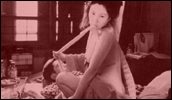A Woman Called Abe Sada
- Year
- 1975
- Original title
- Jitsuroku Abe Sada
- Japanese title
- 実録 阿部定
- Alternative title
- The Abe Sada Story
- Director
- Cast
- Running time
- 76 minutes
- Published
- 20 March 2001


by Jasper Sharp
In 1936 a geisha named Sada Abe was found wandering around the streets of Kyoto with a knife, a rope, and a severed penis in her hands. The latter turned out to belong to her ex-lover Kichi, the rich owner of the hotel where she worked. The two had just spent a month together locked in a violent and passionate amour fou, barely emerging from their hotel room. As Sada's love became more obsessive, she began to take to throttling him to maintain his passion, eventually seeking to possess him entirely.
Reams have been written about Nagisa Oshima's groundbreakingly explicit rendition of this bizarre true story, In the Realm of the Senses (Ai No Koriida, 1976), which became a bit of a cause célèbre upon its release outside of Japan due to an involvement with Frenchman Anatole Dauman (who later produced Shuji Terayama's Fruits of Passion) that allowed hardcore scenes to be shot and shipped out to France for development, thus bypassing Japan's censorship laws. Regardless of the art-versus-pornography debate surrounding Oshima's film, for all the lofty intentions of its makers most people are more likely to remember it for confronting them with their first close-up onscreen blowjob, not to mention the gory emasculation at its climax. Few people outside of Japan, however, are aware that Sada Abe's tale had already made it to the screen a year earlier produced as part of Nikkatsu's Roman Porno line of high-class erotica.
Noboru Tanaka's The Abe Sada Story plays by the rules laid down by the Japanese censors in its rendition of the tale, and unlike Oshima's, which was funded from abroad, was intended entirely for a domestic market. However, though the two films are poles apart in both approach and intention, they both cover pretty much the same ground. A shot by shot comparison would prove very, very interesting indeed, since although both films are aiming at provoking a completely different response, they both deliver a below-the-belt punch whose effectiveness depends very much on the strength of any castration anxiety of the individual viewer.
Whereas Oshima's version focuses intensely on the short period of time within which the liaison occurs, Tanaka introduces Sada's character in a series of antique still photographs and slips in a flashback towards the end of the film detailing her unhappy childhood and rape at the age of 16. The same tyings-up, strangulations, and erotic food incidents are present in both, yet there seem to be rather more scenes of her alone playing with sharp objects in this version. Tanaka's version is certainly the more accessible of the two. Aside from being less sexually explicit, it is also smaller scale, more intimate, more cinematically stylised and arguably more erotic.
Tanaka made a number of films for Nikkatsu including Watcher in the Attic (Edogawa Rampo Ryokikan: Yaneura no Sanpo Sha, 1976) based on a story by Edogawa Rampo, and the third in the Angel Guts series, Nami (Tenshi no Harawata: Nami, 1980). He is regarded as one of their most accomplished directors of the period. Junko Miyashita, who plays Sada, was a successful Nikkatsu starlet who starred in the prior to this had appeared in a number of entries in the Apartment Wife series of mainstream softcore between 1972 and 1974.
As if these two versions of the same story weren't enough, Nobuhiko Obayashi gave us his take on events in the more recent Sada (1998), a glossy MTV-styled version which by all accounts is more concerned with the backstory than the intimate details of the relationship between Sada and Kichi. It looks like this story could just run and run.